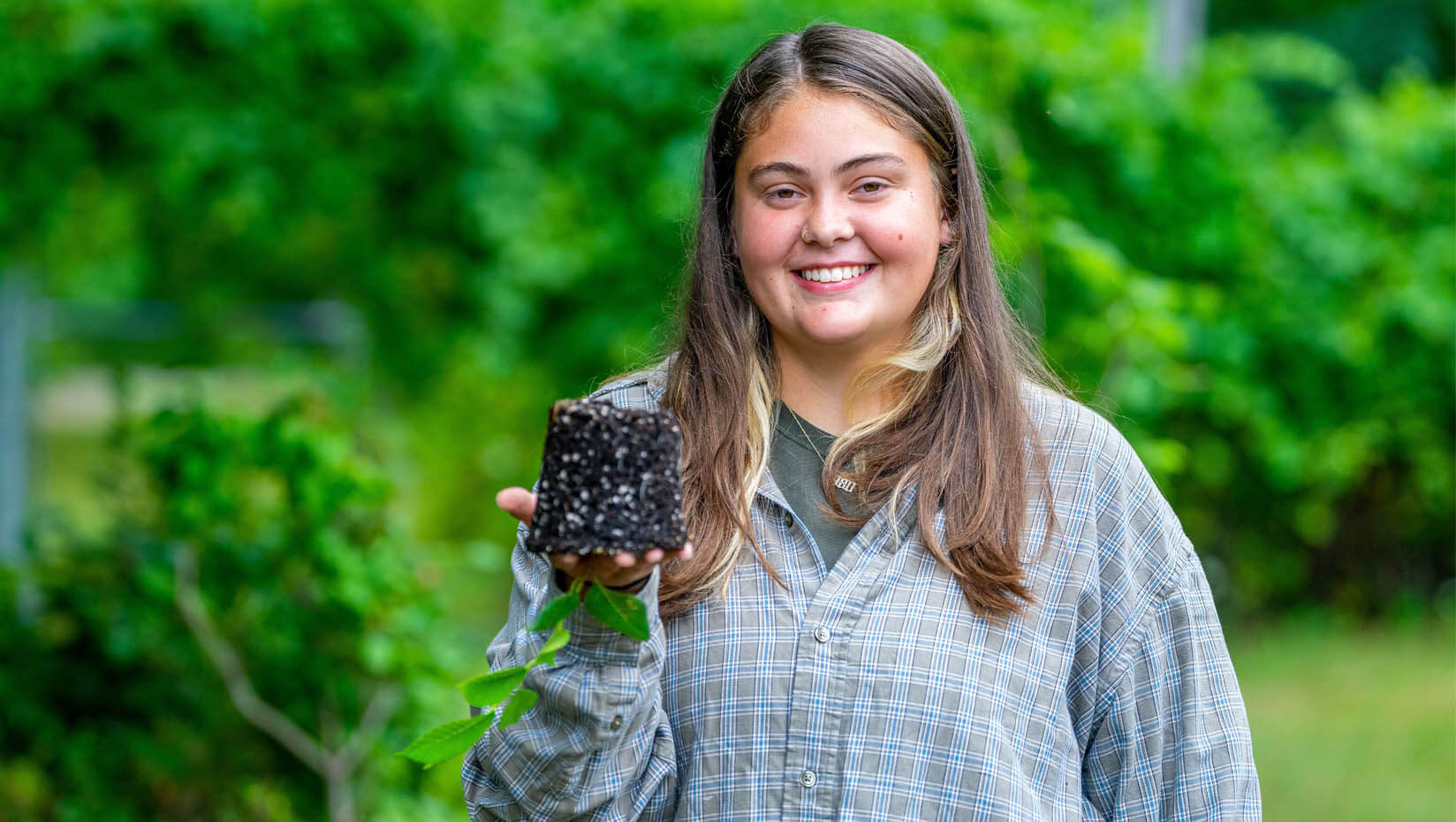
Makaila Bailey: Continuing the legacy of the Campana elm with cutting propagation
Makaila Bailey of Pittsfield, Maine, a student in the University of Maine Environmental Horticulture Program, is working alongside Bradly Libby, superintendent of the Roger Clapp Greenhouses, Littlefield Garden and the Fay Hyland Botanical Garden, to grow rooted stem cuttings from the historical Campana elm.
The elm, which was over 150 years old and sited next to Hitchner Hall on campus, was named after internationally recognized plant pathologist Richard Campana who saved the tree with pioneering Dutch Elm disease research. The tree’s significance also inspired the establishment of a Campus Natural Heritage Endowment Fund in the University of Maine Foundation. The Campana elm was taken down earlier this month after arborists determined the main trunk of the tree was nearly fully rotted and it would not survive a major wind storm.
Bailey and Libby have been working throughout summer to collect and root cuttings from the elm that will hopefully bring back the legacy of a tree that is said to have predated the establishment of the university.
Libby met Bailey in fall 2021 when she was a student in his Woody Landscaping Plants class.
“Makaila was an outstanding student in class, not only was she smart but she was involved and engaged, and I had been thinking to myself how great it would be to have her work for me,” says Libby. So when Bailey approached Libby at the end of the semester and asked what he thought she should do for her required field experience, Libby’s response was “you could work for me.”
When Bailey started, she says she had no idea she was going to be involved with saving a UMaine historical landmark. But when Libby happened to mention to her that he had been collecting cuttings from the Campana elm, Bailey’s interest peaked and she offered to help.
“There were other students involved early on, but as time went on it became Makaila’s project, frankly because she was familiar with it, she’s a very good anticipator and can see the big picture. It was really easy for me to just collect the cuttings and Makaila knew what to do with them,” says Libby.
Bailey and Libby had been collecting around 30 cuttings about every two weeks from May to when the elm was cut down in August. They had originally hoped to gather seeds as well, but there were no viable options, which made the cutting propagation even more important. As the cuttings root, Makaila has begun to pot them.
“This is really exciting because it’s not a guarantee just because you go through the procedure that you will see the roots grow. But this is just the first step, now we have to keep the deer off them and get them through the winter,” says Libby.
The goal for Bailey and Libby is to have the cuttings eventually ready to be replanted on campus, as other elm cuttings have been through the decades at UMaine. Libby says locations have not yet been determined, but it will need to be areas with good soil and somewhere people can enjoy them.
In order for a tree to be replanted it needs to be the ideal size. The campus is a high-traffic area and they will need to wait to replant when the trunks are at least 2 inches in diameter to ensure the safety of the trees.
“As a student, it’s really cool to be involved in something that was so important to the campus. I didn’t know anything about sticking cuttings or propagating trees before working for Brad so this whole process has been a learning experience for me and it’s really been a lot of fun,” says Bailey.
Before coming to UMaine, Bailey visited the Surry Gardens in Surry, Maine and from this trip realized that was what she wanted to do in her future.
“I Googled what I could do with greenhouses and business; and horticulture came up. From there, I looked up schools that offer horticulture programs and UMaine was the best option for me. There are so many opportunities here and it’s been amazing to connect with the people in my major and the professors have helped me a lot,” she says.
Bailey plans to continue working with Libby throughout her upcoming senior year at UMaine. They hope that everything will go smoothly as they transition to keep the cuttings alive when it gets colder. In the winter, Libby says there are many options they will have to explore in order to ensure the survival of the elm.
Contact: Margaret Nagle, nagle@maine.edu
